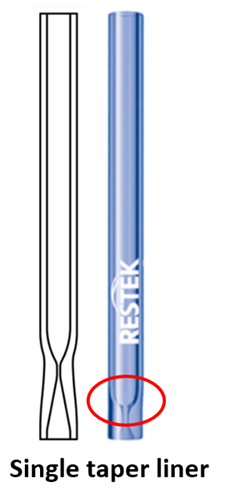Greetings and welcome! I'm Bhaskar Napte from Pharma Growth Hub, and today we're delving into the world of tapered GC inlet liners. You've probably come across these essential components within the GC injector port, with various design options tailored to specific applications. Our focus today revolves around the remarkable advantages of tapered GC inlet liners.
To kick things off, let's start by understanding what an inlet liner is. The accompanying diagram illustrates a glass tube safeguarding the sample from direct contact with the metal components of the injector port. It's crucial to note that this inlet liner must be composed of inert materials.

In the realm of injection techniques, we encounter two prominent methods: split and splitless. Each technique calls for a distinct type of inlet liner. Our discussion today will focus on the design of liners for both split and splitless injections. However, let's first unravel the concept of taper.

Tapering, by definition, involves gradually narrowing toward one end. As depicted in the three diagrams as below, one end gradually tapers to a finer point. This geometric feature is known as a taper or tapered geometry.

In the case of inlet liners, this taper geometry is employed. As shown in the diagram, one end of the liner tapers gradually, giving rise to the single taper liner.

There is also the option of a double taper liner, where both ends taper inwards, aptly named the double taper liner.

Now, let's address the central theme of our discussion: why do inlet liners have a taper, and what purpose does it serve? There are two key reasons.
1. The bottom taper serves to minimize contact with the metal components of the inlet and concentrates the sample at the head of the column. This concentration is evident in the diagram, where the sample is directed towards the column head, reducing contact with metal surfaces. The narrower taper narrows the sample band, enhancing chromatographic results.

2. The top taper aids in preventing sample flashback. After injection, the sample vaporizes and increases in volume. A liner without a top taper might fail to contain this expanded volume, resulting in flashback – an undesirable outcome where the sample travels into carrier gas or septum purge lines. Flashback leads to inconsistent results between injections, including ghost peaks and cross-contamination. The top taper effectively curtails flashback by preventing the transfer of vaporized sample to these lines.

3. The bottom taper with a narrower inner diameter is recommended for ensuring a tight sample band, resulting in sharper peaks.
4. Double taper liners improve reproducibility from one injection to the next by minimizing sample loss, making them particularly beneficial for trace-level analysis and splitless injection modes. Double taper liners are highly recommended for:
Trace level analysis: Ideal for analytes with low concentrations, enhancing sample recovery and transfer to the column.
Splitless mode with low boiling point compounds: Double taper design aids in vaporizing and transferring low boiling point compounds efficiently.
High boiling point diluents: Improves vapor homogeneity and consistency in the presence of high boiling point diluents.
For situations where glass wool is unsuitable: If Glass wool is unsuitable, double-taper glass inlet liners offer an effective alternative to boost vaporization and homogenization.
If you're aware of other reasons to consider using tapered glass inlet liners, please share your insights in the comments below. Thank you for joining us in exploring the world of tapered GC inlet liners.

Comentarios